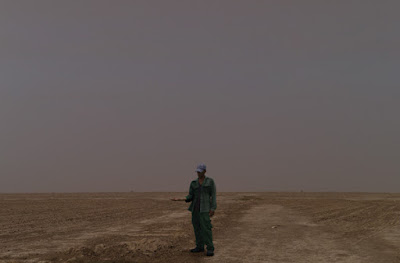Infinite Freedom Exercise (near Abadan, Iran), 2011
Lincoln Square, Manchester, UK
24 hours a day until 17 July
Lincoln Square, Manchester, UK
24 hours a day until 17 July
Image: John Gerrad
Chelsea Ward, contributorA new video installation by John Gerrard uses top-quality motion-capture graphics to present a soldier eternally training in the Iranian desert
WHEN artist John Gerrard set out to create real-time virtual worlds, he and his team evaluated the top video games - and found them lacking.
"Movement was crap, basically," Gerrard says. "Even the very high-end, huge-budget games had flaws in their motion." Gamers don't mind these small flaws, Gerrard says, because they are of little importance compared with the plot. In his artwork, however, there is no plot: "The narrative is the motion."
Gerrard's outdoor LED wall installation at the Manchester International Festival, Infinite Freedom Exercise (near Abadan, Iran), 2011, displays a soldier continuously performing about 160 dance-like motions in an Iranian desert landscape, beneath a sun that rises and sets on Iranian local time.
Despite the starting point of Gerrard's research, there is nothing very game-like or even movie-like about his work, which might be better compared to scientific simulations. Gerrard sets the parameters and then simply lets the scene evolve. At a 2009 exhibition of his work in New York, curator and art historian Linda Norden described it as a way "to visualise a past-into-future epic history painting: something that unfolds in real time and extends into a future that we can't yet know".
If viewers are to engage with the piece, it has to look real - or, more accurately, hyperreal, says Gerrard. They might just dismiss it if the graphics are bad. The video games he had looked at used the popular technique of "skeletal animation", which is based on the movement of a character's bones and joints, but is limited when it comes to the look of skin, muscles and other "deformations".
So he and his team decided on a different approach, one that would look as good as a Hollywood film - think Gollum in The Lord of the Rings - even though it risked being too data-heavy for real-time action. First, using a 3D motion-capture system, his team recorded dancer Davide de Pretore performing movements derived from the duck-and-cover positions that real soldiers take during mortar-firing exercises.
Then, in an adaptation of a technique called "morph target animation", they translated each move into a frame-by-frame series of dense "meshes" consisting of about 100,000 points. Each of these could then be manipulated to make the virtual soldier look just as Gerrard would like - a portrait of sorts. At his studio in Vienna, Austria, last month, Gerrard and his team were still fine-tuning the soldier's look and movements. They hadn't yet done his hands, which dangled woodenly - a strange sight.
The soldier moves within an equally meticulously modelled virtual landscape - complete with 365 days of accurate light conditions - that Gerrard photographed in 2008 on a trip to Iran, inspired by a 1980 photo from the Iran-Iraq war. The point of view comes from a virtual camera orbiting the soldier.
The work is too much of a mash-up of times, places and people to be interpreted as a commentary on any specific conflict, but it is obviously a critique of violence and power. In a way, it is also a product of the violence that it is critiquing, since many gaming technologies have military origins. Even the lab in Prague, Czech Republic, that performed the 3D motion capture deals mainly in military applications.
Although Gerrard holds a master's in computer science, he no longer does any programming. He directed the work, while his producer, Werner Pötzelberger, coordinated the team of programmers. It took a team of eight about five months to create. Among their tasks was creating a custom solution to handle the piece's whopping 300 gigabytes of animation data and streaming rate of 100 megabytes per second.
This team-oriented production model comes from the world of computer science, not art, Gerrard says. And that's not all that makes him an outsider in the art world. In fact, as a real-time virtual artist, Gerrard is basically alone, Norden says, "like the mad scientist".
John Gerrard talks about his new MIF project 'Infinite Freedom Exercise'
Via Manchester International Festival and New Scientist


No comments:
Post a Comment